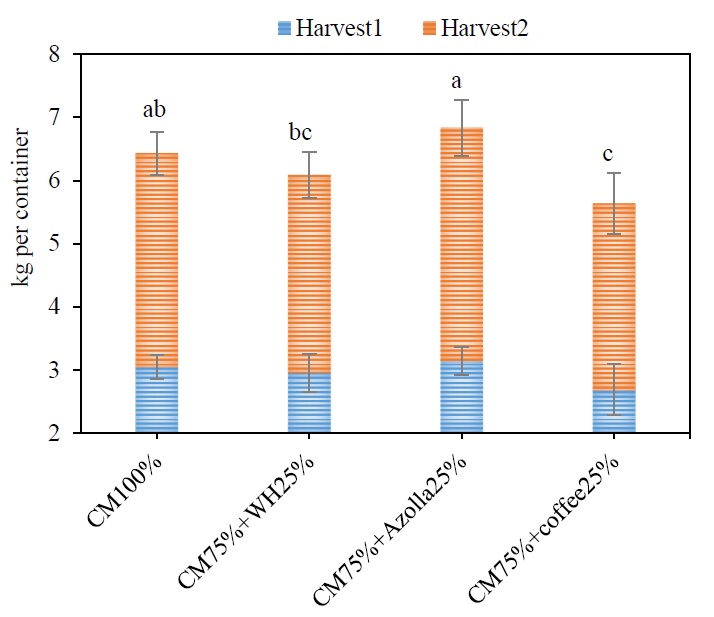Alternative Feed Sources for Vermicompost Production 10.32526/ennrj/20/202200009
Main Article Content
Abstract
Locally-available materials could be used to address soil fertility constraints. Vermicomposting is a promising technology where various organic materials are converted into processed compost by earthworms. This study evaluated local feed sources and their potential for vermicompost production. The vermicompost production was carried out in the plastic container under a roofed and net-sided production house. The plot design was laid out in Completely Randomized Design (CRD) with nine replications. Vermiculture feedstock treatments were cow manure (CM) and three cow manure and alternative feed stock treatments (75:25 on a dry basis) that included water hyacinth (WH), used coffee grounds (coffee), or Azolla. The results showed that cow manure combined with Azolla tended to produce more vermicompost after four weeks, but post-harvest earthworm weight was lower. The cow manure treatment produced higher earthworm weights. However, the earthworm population was not influenced by feed sources. The chemical characteristics of vermicompost were not different among feed source ratios or combination. A comparison of the feed stock material before and after vermiculture composting show that EC and total P increased in the compost, total K, organic C and the C:N ratio decreased, but pH and Total N remained constant.
Article Details

This work is licensed under a Creative Commons Attribution-NonCommercial 4.0 International License.
Published articles are under the copyright of the Environment and Natural Resources Journal effective when the article is accepted for publication thus granting Environment and Natural Resources Journal all rights for the work so that both parties may be protected from the consequences of unauthorized use. Partially or totally publication of an article elsewhere is possible only after the consent from the editors.
References
Amouei AI, Yousefi Z, Khosravi T. Comparison of vermicompost characteristics produced from sewage sludge of wood and paper industry and household solid wastes. Journal of Environmental Health Science and Engineering 2017; 15:Article No. 5.
Ansari AA, Rajpersaud J. Physicochemical changes during vermicomposting of water hyacinth (Eichhornia crassipes) and grass clippings. International Scholarly Research Notices 2012;2012:Article No. 984783.
Ayilara MS, Olanrewaju OS, Babalola OO, Odeyemi O. Waste Management through composting: Challenges and Potentials. Sustainability 2020;12(11):Article No. 4456.
Blouin M, Barrere J, Meyer N, Lartigue S, Barot S, Mathieu J. Vermicompost significantly affects plant growth: A meta-analysis. Agronomy Sustainable Development 2019;39(4): Article No. 34.
Deepthi MP, Kathireswari P, Rini J, Saminathan K, Karmegam N. Vermitransformation of monogastric Elephas maximus and ruminant Bos taurus excrements into vermicompost using Eudrilus eugeniae. Bioresource Technology 2021;320:Article No. 124302.
Dolliver H, Gupta S, Noll S. Antibiotic degradation during manure composting. Journal of Environmental Quality 2008;37:1245-53.
Juarez PDA, Fuente JL, Paulin RV. Vermicomposting as a process to stabilize organic waste and sewage sludge as an application for soil. Tropical and Subtropical Agroecosystems 2011; 14:949-63.
Jayakumar M, Emana AN, Subbaiya R, Ponraj M, Ashok Kumar KK, Muthusamy G, et al. Detoxification of coir pith through refined vermicomposting engaging Eudrilus eugeniae. Chemosphere 2022;291:Article No. 132675.
Karmegam N, Vijayan P, Prakash M, Paul JA. Vermicomposting of paper industry sludge with cowdung and green manure plants using Eisenia fetida: A viable option for cleaner and enriched vermicompost production. Journal of Cleaner Production 2019; 228:718-28.
Kitou M, Okuno S. Decomposition of coffee residue in soil. Journal of Soil Science and Plant Nutrition 1999;45:981-5.
Kumari V, Paul S CH, Singh M, Kumar A, Pradhan AK. Quality characterisation of vermicompost produced from crop residue and cow dung. International Journal of Current Microbiology and Applied Science 2020;9:776-82.
Nath G, Singh K, Singh D. Chemical analysis of vermicomposts/vermiwash of different combinations of animal, agro and kitchen wastes. Journal of Basic and Applied Science 2009;3:3671-6.
Palm CA, Gachengo CN, Delve RJ, Cadisch G, Giller KE. Organic inputs for soil fertility management in tropical agroecosystems: Application of an organic resource database. Agriculture, Ecosystems and Environment 2001;83:27-42.
Parthasarathi K, Balamurugan M, Prashija KV, Jayanthi L, Ameer Basha S. Potential of Perionyx excavatus (Perrier) in lignocellulosic solid waste management and quality vermifertilizer production for soil health. International Journal Recycline Organic Waste Agriculture 2016;5:65-86.
Ramnarain YI, Ansari AA, Ori L. Vermicomposting of different organic materials using the epigeic earthworm Eisenia foetida. International Journal of Recycling Organic Wastes in Agriculture 2019;8:23-36.
Razakatiana ATE, Trap J, Baohanta RH, Raherimandimby M, Le Roux C, Duponnois R, et al. Benefits of dual inoculation with arbuscular mycorrhizal fungi and rhizobia on Phaseolus vulgaris planted in a low-fertility tropical soil. Pedobiologia 2020;83:Article No. 150685.
Wako RE. Preparation and characterization of vermicompost made from different sources of materials. Open Journal of Plant Science 2021;6(1):42-8.
Seng V, Ros C, Bell RW, White PF, Hin S. Nutrient requirements of rainfed lowland rice in Cambodia. Proceedings of an International Workshop; 2001 Oct 30-Nov 2; Vientiane: Laos; 2001.
Setiawati MR, Damayani M, Herdiyantoro D, Suryatmana P, Anggraini D, Khumairah FH. The application dosage of Azolla pinnata in fresh and powder form as organic fertilizer on soil chemical properties, growth and yield of rice plant. Proceedings of the 1st International Conference and Exhibition on Powder Technology Indonesia; 2017 Aug 8-9; Jatinangor: Indonesia; 2018.
Smithson PC, Giller K. Appropriate farm management practices for alleviating N and P deficiencies in low-nutrient soils of the tropics. In: Adu-Gyamfi JJ, editor. Food Security in Nutrient-Stressed Environments: Exploiting Plants’ Genetic Capabilities. Dordrecht, Netherlands: Springer; 2002. p. 277-88.
Suthar S. Development of a novel epigeic-anecic-based polyculture vermireactor for efficient treatment of municipal sewage water sludge. International Journal of Environment and Waste Management 2008;2:84-101.
Wang F, Miao L, Wang Y, Zhang M, Zhang H, Ding Y, et al. Using cow dung and mineral vermireactors to produce vermicompost for use as a soil amendment to slow Pb2+ migration. Applied Soil Ecology 2022;170:Article No. 104299.
Yuvaraj A, Thangaraj R, Ravindran B, Chang SW, Karmegam N. Centrality of cattle solid wastes in vermicomposting technology: A cleaner resource recovery and biowaste recycling option for agricultural and environmental sustainability. Environmental Pollution 2021;268:Article No. 115688.

